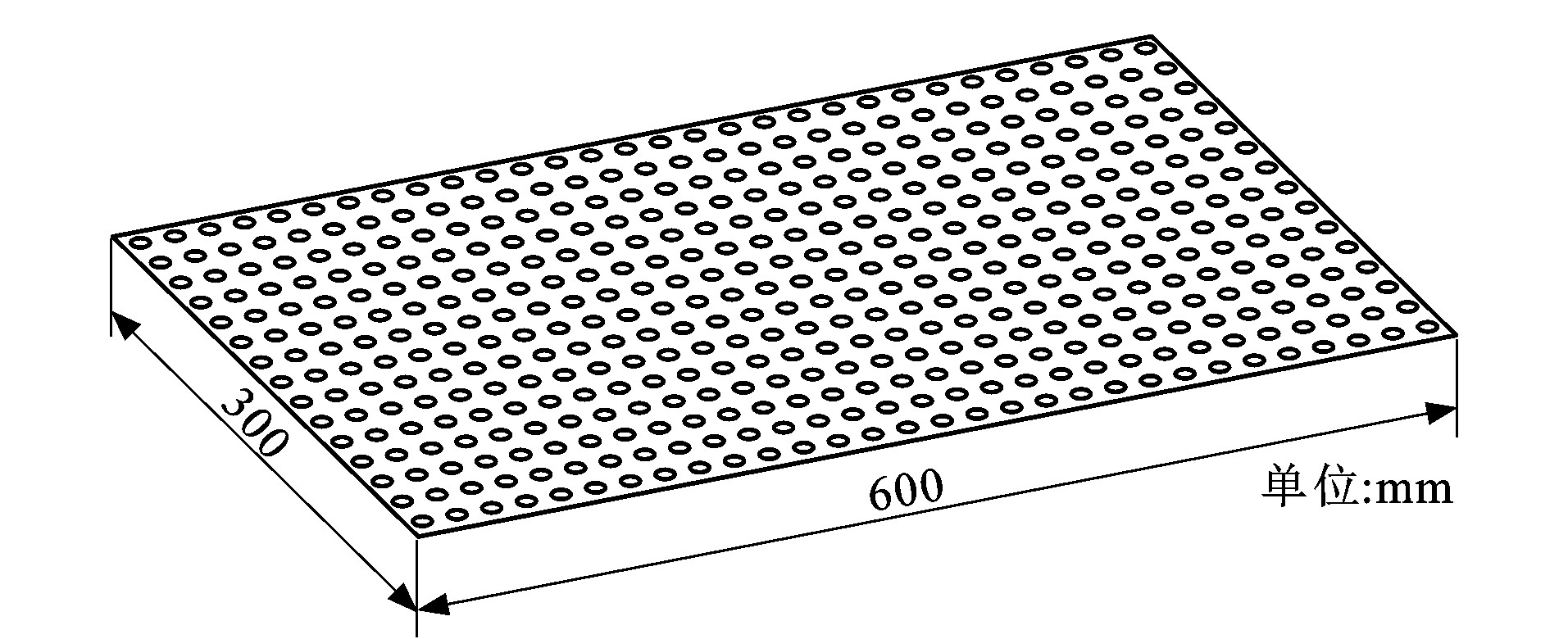Rapid analysis method of weight-reduced orifice plate structure based on stiffness equivalence model
-
摘要: 为了能够更有效率地对减重孔板结构进行计算分析, 提出一种快速分析方法; 研究了减重孔板结构模型与平面板结构模型间的一般刚度等效关系, 建立了减重孔板孔径、孔距与相应平面板等效杨氏模量、等效板厚间的关系表达式, 以等效平面板结构模型代替原孔板结构模型进行变形分析; 将局部节点位移施加到相应目标孔位模型上, 计算了目标孔位区域的应力分布; 结合试验与仿真验证了方法的准确性; 通过对某实际减重孔板结构施加不同载荷, 对刚度等效关系的稳定性进行了验证; 通过某车体底架带孔板结构实例, 对方法应用于实际工程中的有效性进行了验证。分析结果表明: 与试验结果相比, 快速分析方法仿真变形最大误差约为3%, 应变的最大误差约为5%;不同载荷下的等效杨氏模量偏差约为2.5%, 等效板厚的偏差约为1.3%;快速分析方法对变形与局部应力的平均计算误差小于6.7%, 计算时间缩短了约50%。可见, 快速分析方法可以替代传统方法对减重孔板结构进行性能分析。Abstract: In order to calculate and analyze the structure of weight-reduced orifice plate more efficiently, a rapid analysis method was proposed. The general stiffness equivalence relationship between weight-reduced orifice plate structure model and planar plate structure model was researched. The relational expressions were established between the aperture, hole distance of weight-reduced orifice plate, the equivalent Young's modulus, and thickness of corresponding planar plate. The orifice plate structure model was replaced with equivalent planar plate structure model for deformation analysis. The local node displacement was applied to corresponding target hole model, and the stress distribution of target hole area was calculated. The accuracy of proposed method was verified by experiments and simulations. The stability of stiffness equivalence relationship was verified by applying different loads to an actual weight-reduced orifice plate structure. The effectiveness of the method in practical engineering was verified by an example of a car body chasis with orifice plate. Analysis result shows that compared with experimental results, the maximum error of deformation of rapid analysis method is about 3%, and the maximum error of strain is about 5%. Under different loads, the deviation of equivalent Young's modulus is about 2.5%, and the deviation of equivalent plate thickness is about 1.3%. The average calculation error of deformation and local stress of rapid analysis method is less than 6.7%, and the calculation time is shortened by about 50%. So, the rapid analysis method can replace the traditional method to analyze the performance of weight-reduced orifice plate structure.
-
表 1 孔径与孔距组合
Table 1. Aperture and hole distance combinations
mm 孔径 5 5 5 6 6 6 7 7 7 8 8 8 孔距 20 25 30 20 25 30 20 25 30 20 25 30 表 2 材料参数
Table 2. Material parameters
参数 密度/ (kg·m-3) 泊松比 弹性模量/MPa 屈服极限/MPa 数值 7 800 0.3 2.06×105 235 表 3 矩形平面板平均位移与平均转角
Table 3. Average displacements and angles of rectangular planar plates
平面板序号 杨氏模量/1011 Pa 板厚/mm 平均位移/10-7 mm 平均转角/rad 1 1.0 1.0 3.006 3.563 2 1.0 1.5 2.004 1.056 3 1.0 2.0 1.503 0.445 4 1.0 2.5 1.203 0.228 5 1.5 1.0 2.004 2.376 6 1.5 1.5 1.336 0.704 7 1.5 2.0 1.002 0.297 8 1.5 2.5 0.802 0.152 9 2.0 1.0 1.503 1.782 10 2.0 1.5 1.002 0.528 11 2.0 2.0 0.752 0.223 12 2.0 2.5 0.601 0.114 13 2.5 1.0 1.202 1.425 14 2.5 1.5 0.802 0.422 15 2.5 2.0 0.601 0.178 16 2.5 2.5 0.481 0.091 表 4 孔板的等效杨氏模量与板厚
Table 4. Equivalent Young's moduli and thicknesses of orifice plates
组合序号 孔径/mm 孔距/mm 等效杨氏模量/1011 Pa 等效板厚/mm 1 5 20 1.234 2.06 2 5 25 1.474 2.05 3 5 30 1.714 2.03 4 6 20 0.998 2.06 5 6 25 1.305 2.06 6 6 30 1.502 2.05 7 7 20 0.747 2.07 8 7 25 1.115 2.06 9 7 30 1.322 2.06 10 8 20 0.497 2.07 11 8 25 0.929 2.07 12 8 30 1.209 2.06 表 5 不同测点3个方向的应变
Table 5. Strains in three directions of different measuring points
测点 方法 ε1/10-4 ε2/10-5 ε3/10-6 1 DIC试验 -3.99 8.67 9.70 快速分析方法 -3.67 8.55 10.20 2 DIC试验 -0.28 -9.41 1.02 快速分析方法 -0.31 -9.38 1.03 3 DIC试验 -3.99 8.71 -11.40 快速分析方法 -3.69 8.68 -10.50 4 DIC试验 -0.26 -7.81 -1.23 快速分析方法 -0.31 -7.88 -1.18 表 6 不同力系下的等效杨氏模量与等效板厚
Table 6. Equivalent Young's moduli and thicknesses under different force systems
力系 拉力/N 弯矩/ (N·m) 等效杨氏模量/1011 Pa 等效板厚/mm 1 3 3 1.58 2.06 2 6 6 1.55 2.05 3 9 9 1.60 2.04 4 12 12 1.64 2.03 5 15 15 1.61 2.04 表 7 不同载荷下的垂向挠度
Table 7. Vertical deflections under different loads
工况 外载荷/N 模型 挠度/cm 误差/% 1 20 底架减重孔板 13.40 6.7 等效平面板 12.50 2 4 底架减重孔板 2.68 6.6 等效平面板 2.50 表 8 快速分析方法与传统方法应力对比
Table 8. Stress comparison between rapid analysis method and traditional method
孔位序号 快速分析方法得到最大应力/1011 Pa 传统方法得到最大应力/1011 Pa 误差率/% 平均误差率/% 1 1.58 1.63 3.1 4.5 2 1.72 1.65 4.2 3 1.79 1.86 3.7 4 1.76 1.64 7.3 5 1.73 1.66 4.2 -
[1] 洪求才, 刘卫国, 周大永. 某款轿车变型开发中车身结构轻量化的研究[J]. 汽车工程, 2017, 39 (2): 232-236. https://www.cnki.com.cn/Article/CJFDTOTAL-QCGC201702018.htmHONG Qiu-cai, LIU Wei-guo, ZHOU Da-yong. A study on body structure lightweighting in the transfiguration development of a sedan[J]. Automotive Engineering, 2017, 39 (2): 232-236. (in Chinese). https://www.cnki.com.cn/Article/CJFDTOTAL-QCGC201702018.htm [2] 毛爱华. 纯电动大客车骨架结构轻量化多目标优化设计[D]. 长春: 吉林大学, 2015.MAO Ai-hua. Multi-objective optimization design for electric bus body skeleton structure lightweight[D]. Changchun: Jilin University, 2015. (in Chinese). [3] 徐力, 刘荣桂, 韦芳芳. 开孔板的有限元分析[J]. 江苏大学学报(自然科学版), 2002, 23 (5): 28-30. doi: 10.3969/j.issn.1671-7775.2002.05.007XU Li, LIU Rong-gui, WEI Fang-fang. Analysis of plates with openings by finite element method[J]. Journal of Jiangsu University (Natural Science), 2002, 23 (5): 28-30. (in Chinese). doi: 10.3969/j.issn.1671-7775.2002.05.007 [4] 王登峰, 卢放. 基于多学科优化设计方法的白车身轻量化[J]. 吉林大学学报(工学版), 2015, 45 (1): 29-37. https://www.cnki.com.cn/Article/CJFDTOTAL-JLGY201501005.htmWANG Deng-feng, LU Fang. Body-in-white lightweight based on multidisciplinary design optimization[J]. Journal of Jilin University (Engineering and Technology Edition), 2015, 45 (1): 29-37. (in Chinese). https://www.cnki.com.cn/Article/CJFDTOTAL-JLGY201501005.htm [5] 兰凤崇, 庄良飘, 钟阳, 等. 乘用车车身结构轻量化设计技术研究与实践[J]. 汽车工程, 2010, 32 (9): 763-768, 773. https://www.cnki.com.cn/Article/CJFDTOTAL-QCGC201009005.htmLAN Feng-chong, ZHUANG Liang-piao, ZHONG Yang, et al. Study and practice of car body structure lightweight design[J]. Automotive Engineering, 2010, 32 (9): 763-768, 773. (in Chinese). https://www.cnki.com.cn/Article/CJFDTOTAL-QCGC201009005.htm [6] 谭祖龙. 圆形孔口多孔板的有限元分析[J]. 现代制造技术与装备, 2017 (3): 78, 83. https://www.cnki.com.cn/Article/CJFDTOTAL-SDJI201703039.htmTAN Zu-long. Finite element analysis of circular orifice plate[J]. Modern Manufacturing Technology and Equipment, 2017 (3): 78, 83. (in Chinese). https://www.cnki.com.cn/Article/CJFDTOTAL-SDJI201703039.htm [7] 唐慧敏, 吴思, 张惠敏. 拓扑优化几何清理及网格划分技巧[J]. 中国战略新兴产业, 2017 (16): 116. https://www.cnki.com.cn/Article/CJFDTOTAL-ZLXC201716092.htmTANG Hui-min, WU Si, ZHANG Hui-min. Topology optimization geometry cleanup and meshing techniques[J]. China Strategic Emerging Industry, 2017 (16): 116. (in Chinese). https://www.cnki.com.cn/Article/CJFDTOTAL-ZLXC201716092.htm [8] 李环, 邓洁, 张琪, 等. 基于DOE的某异型喷管结构优化减重研究[J]. 南京航空航天大学学报, 2017, 49 (增): 40-44. https://www.cnki.com.cn/Article/CJFDTOTAL-NJHK2017S1008.htmLI Huan, DENG Jie, ZHANG Qi, et al. Study on structural optimization and mass reduction of a shaped nozzle based on DOE[J]. Journal of Nanjing University of Aeronautics and Astronautics, 2017, 49 (S): 40-44. (in Chinese). https://www.cnki.com.cn/Article/CJFDTOTAL-NJHK2017S1008.htm [9] 李百建, 朱良生, 符锌砂. 基于刚度等效的钢波纹板叠合梁结构数值分析[J]. 华南理工大学学报(自然科学版), 2018, 46 (12): 111-120. doi: 10.3969/j.issn.1000-565X.2018.12.014LI Bai-jian, ZHU Liang-sheng, FU Xin-sha. Numerical analysis of corrugated steel plate-composite beam structure based on equivalent stiffness method[J]. Journal of South China University of Technology (Natural Science Edition), 2018, 46 (12): 111-120. (in Chinese). doi: 10.3969/j.issn.1000-565X.2018.12.014 [10] 冯岩, 杜国君, 赵卫东. 构造上正交各向异性凹凸板等效刚度的研究[J]. 应用力学学报, 2018, 35 (4): 900-905. https://www.cnki.com.cn/Article/CJFDTOTAL-YYLX201804034.htmFENG Yan, DU Guo-jun, ZHAO Wei-dong. Equivalent stiffness research of the construction orthogonal anisotropy truss core panel[J]. Chinese Journal of Applied Mechanics, 2018, 35 (4): 900-905. (in Chinese). https://www.cnki.com.cn/Article/CJFDTOTAL-YYLX201804034.htm [11] 李百建, 符锌砂, 朱良生. 基于刚度等效的钢波纹板-减压板力学特性研究[J]. 华南理工大学学报(自然科学版), 2018, 46 (9): 131-139. https://www.cnki.com.cn/Article/CJFDTOTAL-HNLG201809019.htmLI Bai-jian, FU Xin-sha, ZHU Liang-sheng. Research on mechanical properties of corrugated steel plate with relieving slab based on equivalent stiffness[J]. Journal of South China University of Technology (Natural Science Edition), 2018, 46 (9): 131-139. (in Chinese). https://www.cnki.com.cn/Article/CJFDTOTAL-HNLG201809019.htm [12] TANAKA S, YANAGIHARA D, YASUOKA A, et al. Evaluation of ultimate strength of stiffened panels under longitudinal thrust[J]. Marine Structures, 2014, 36: 21-50. doi: 10.1016/j.marstruc.2013.11.002 [13] LI Yan, LI Xin-fu, MA Shi-wang. Groundstates for Kirchhoff-type equations with Hartree-type nonlinearities[J]. Results in Mathematics, 2019, 74 (1): 1-26. doi: 10.1007/s00025-018-0927-1 [14] SUN Ling-yu, LENG Ding-xin, SUN Juan-juan, et al. An equivalent stiffness (ES) method for initial design of tube-based energy absorbers under lateral quasi-static compression[J]. Journal of Mechanical Science and Technology, 2015, 29 (2): 637-646. doi: 10.1007/s12206-015-0123-0 [15] DUAN Zun-yi, YAN Jun, LEE I, et al. A two-step optimization scheme based on equivalent stiffness parameters for forcing convexity of fiber winding angle in composite frames[J]. Structural and Multidisciplinary Optimization, 2019, 59 (2): 2111-2129. [16] SUN Hong-lei, YANG Yi-min, SHI Li, et al. The equivalent stiffness of a saturated poroelastic halfspace interacting with an infinite beam under a moving point load[J]. Soil Dynamics and Earthquake Engineering, 2018, 107: 83-95. doi: 10.1016/j.soildyn.2018.01.022 [17] SUN J D, TIAN E, LEI H, et al. The impact of helical gear parameters based on axial meshing transmission on Swash plate pulse CVT characteristics[J]. Applied Mechanics and Materials, 2012, 101/102: 224-227. [18] FENG Xiong, WANG Deng-feng, CHEN Shu-ming, et al. Multi-objective lightweight and crashworthiness optimization for the side structure of an automobile body[J]. Structural and Multidisciplinary Optimization, 2018, 58 (4): 1823-1843. doi: 10.1007/s00158-018-1986-3 [19] SAKUNDARINI N, TAHA Z, ABDUL-RASHID S H, et al. Optimal multi-material selection for lightweight design of automotive body assembly incorporating recyclability[J]. Materials and Design, 2013, 50: 846-857. [20] CHENG Z Q, THACKER J G, PILKEY W D, et al. Experiences in reverse-engineering of a finite element automobile crash model[J]. Finite Elements in Analysis and Design, 2001, 37 (11): 843-860. doi: 10.1016/S0168-874X(01)00071-3 [21] WANG Wen-wei, ZHOU Cheng-jun, LIN Cheng, et al. Electric bus body lightweight design based on multiple constrains[J]. Advanced Materials Research, 2012, 538-541: 3137-3144. doi: 10.4028/www.scientific.net/AMR.538-541.3137 [22] PIERCE A A, PARKER B L, INGLETON R, et al. Novel well completions in small diameter coreholes created using portable rock drills[J]. Groundwater Monitoring and Remediation, 2018, 38 (1): 42-55. doi: 10.1111/gwmr.12257 [23] ISMAIL N, EL-HASSAN H. Development and characterization of fly ash-slag blended geopolymer mortar and lightweight concrete[J]. Journal of Materials in Civil Engineering, 2018, 30 (4): 1-14. [24] BRANCATI R, MASSA G D, PAGANO S, et al. A magneto-rheological elastomer vibration isolator for lightweight structures[J]. Meccanica, 2019, 54 (4): 333-349. [25] WU Jian-ping, NUSHOLTZ G S, BILKHU S. Optimization of vehicle crash pulses in relative displacement domain[J]. International Journal of Crashworthiness, 2012, 7 (4): 397-414. [26] CHENG Xing-lei, YANG Ai-wu, LI Guang-ning. Model tests and finite element analysis for the cyclic deformation process of suction anchors in soft clays[J]. Ocean Engineering, 2018, 151: 329-341. [27] MUCCILLO M, GIMELLI A, SANNINO R. Multi-objective optimization and sensitivity analysis of a cogeneration system for a hospital facility[J]. Energy Procedia, 2015, 81: 585-596. [28] EGE K, ROOZEN N B, LECLÈRE Q, et al. Assessment of the apparent bending stiffness and damping of multilayer plates; modelling and experiment[J]. Journal of Sound and Vibration, 2018, 426: 129-149. [29] FENDER J, DUDDECK F, ZIMMERMANN M. On the calibration of simplified vehicle crash models[J]. Structural and Multidisciplinary Optimization, 2014, 49 (3): 455-469. [30] SIGMUND O, MAUTE K. Topology optimization approaches[J]. Structural and Multidisciplinary Optimization, 2013, 48 (6): 1031-1055. -





 下载:
下载:

















